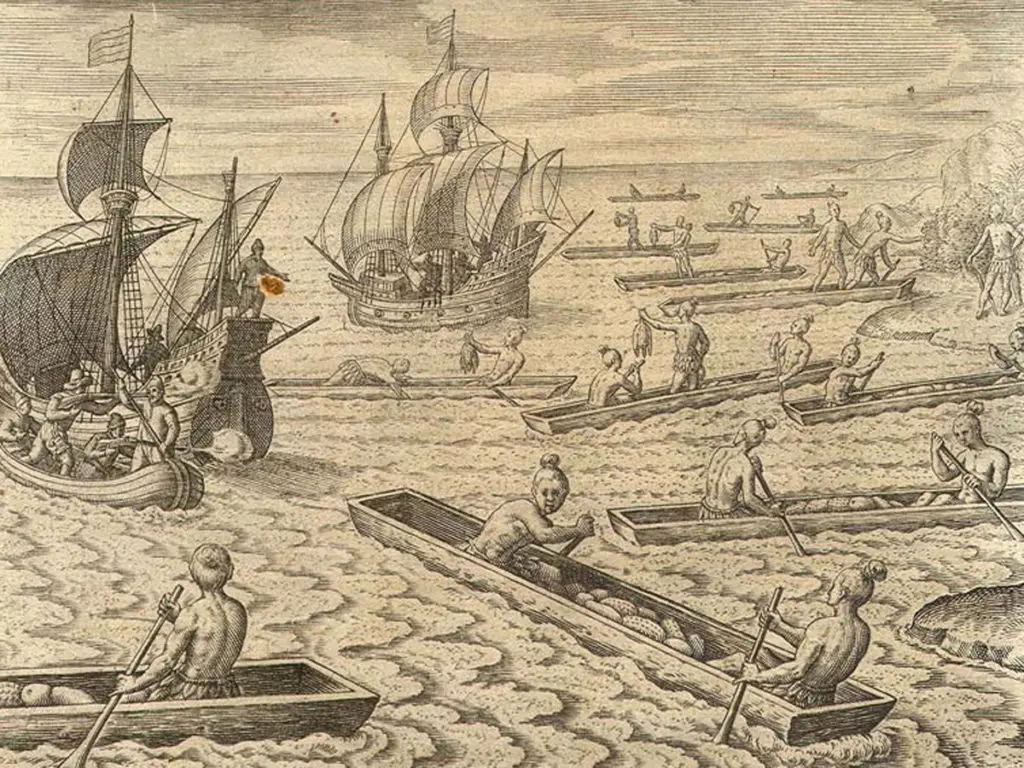
CHamorus asked for help
John Eaton and William Ambrosia Cowley, English pirates, visited Guam in March 1685. Jesuit Father Juan Tilpe wrote in a letter that the ship was first thought to be a Spanish ship from Manila with supplies for the Spanish garrison on Guam. It was then believed to be a French warship since its captain communicated in French.
Eaton asked for supplies for his scurvy-suffering crew, trading gunpowder and several rifles for pigs, corn, rice, and other foods.
Arriving on Guam at the height of the Spanish-CHamoru Wars, the crew found the governor Don Damian Esplaña in a state of unease, reporting that a chief named Yula had fought the Spaniards less than a year before, wounding the governor and killing several priests and soldiers.
Cowley wrote that the sailors were well-received by the CHamorus, who brought them:
potatoes, mananoes, coconuts and plantains, selling them to us for old nails and old iron. But they being treacherous, we trusted them not for we had always our small arms ready, and great guns loaden with round balls and cartridges. Sometimes we would have our deck full with these infidels but we were always in arms.
Some of the Englishmen went fishing with the CHamorus when the CHamrous surrounded the boat with a net as though to draw it ashore together with its crew, Crowley noted. The crew reacted by shooting at the CHamorus.
(We) let go in amongst the thickest of them and killed a great many of their number while the others, seeing their mates fall, ran away. Our other men which were on shoar meeting them, saluted them also by making holes in their hides.
We took our boat immediately thereupon, and went on board, most of our well men being on shoar, and seeing many of these infidels’ boats lie along our ship’s side, did not know what design they might have on board (against) our sick men, but as it fell out, there were boats which came from the governor, with more presents for our refreshment.
Several CHamorus approached “the French” to seek an alliance with them to “wipe out all the Spanish.”
We took four of these infidels prisoners, and brought them on board, binding their hands behind them. But they had not been long there, when three of them leaped overboard into the sea, swimming away from the ship with their hands tied behind them. However we sent the boat after them and found a strong man at the first blow could not penetrate their skins with a cutlace. One of them had received in my judgment, forty shots in his body before he died. And the last of the three that was killed had swam a good English mile first not only with his hands tied behind him, as before, but also with his arms pinion’d.
The governor rewarded the pirates for killing the CHamorus by giving them more supplies after which they saluted him with three guns and sailed away on 11 April, leaving behind CHamorus reluctant to attempt to make alliances with any other visiting ships. Shortly after Eaton was gone, the CHamorus nevertheless launched another assault against the Spaniards, killing several soldiers but failing to dislodge them from their Hagåtña fort.
By Nicholas J. Goetzfridt, PhD and Shannon J. Murphy
For further reading
Cowley, William Ambrosia. “A Short Account of My Voyage Round this Terestiall Globe of the World from Virginia to England and through the Great South Sea.” Miscellanea Curiosa 4, (1686).
Hacke, William. A Collection of Original Voyages. Delmar: Scholars’ Facsimiles & Reprints, 1993.
